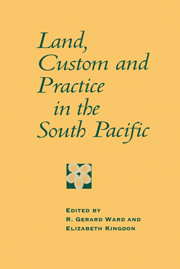Book contents
- Frontmatter
- Contents
- List of Figures
- List of Tables
- Contributors
- Acknowledgements
- Introduction
- 1 Land Use and Tenure: Some Comparisons
- 2 Land Tenure in the Pacific Islands
- 3 Breathing Spaces: Customary Land Tenure in Vanuatu
- 4 From Corporate to Individual Land Tenure in Western Samoa
- 5 Right and Privilege in Tongan Land Tenure
- 6 Land, Law and Custom: Diverging Realities in Fiji
- 7 Beyond the Breathing Space
- Bibliography
- Index
4 - From Corporate to Individual Land Tenure in Western Samoa
Published online by Cambridge University Press: 10 November 2009
- Frontmatter
- Contents
- List of Figures
- List of Tables
- Contributors
- Acknowledgements
- Introduction
- 1 Land Use and Tenure: Some Comparisons
- 2 Land Tenure in the Pacific Islands
- 3 Breathing Spaces: Customary Land Tenure in Vanuatu
- 4 From Corporate to Individual Land Tenure in Western Samoa
- 5 Right and Privilege in Tongan Land Tenure
- 6 Land, Law and Custom: Diverging Realities in Fiji
- 7 Beyond the Breathing Space
- Bibliography
- Index
Summary
Individual land tenure is now widely established in Western Samoa, and with it economic individualism. The process has taken well over a century, however, and it has not been easy. Early missionary attempts to instil individualism in the Samoans went unheeded (Meleisea, 1987:18). The missionary, George Turner, lamented that:
[the] system of common interest in each other's property … is still clung to by the Samoans with great tenacity. … This communistic system is a sad hindrance to the industrious, and eats like a canker-worm at the roots of individual or national progress. (1884:160)
Speaking of that early era, Meleisea argued that:
The foundation of the Samoan economy and fa'a Samoa [the ‘Samoan way’] was subsistence agriculture based on descent group tenure and ownership of land, and for social and political institutions to have changed, the system of land tenure would have had to change. The Samoan system made economic individualism impossible. (1987:18)
Later, the New Zealand administration's attempts to ‘press the evolution of land usage toward individualism provoked opposition, even though of their own momentum changes seem to be slowly setting in that direction’ (Keesing, 1934:287). On the eve of independence, Marsack warned that ‘while the matai [chiefly] system still stands in Western Samoa there can necessarily be no individual ownership of small pieces of Samoan customary land or small plantations thereon’ (1961:28).
- Type
- Chapter
- Information
- Land, Custom and Practice in the South Pacific , pp. 109 - 156Publisher: Cambridge University PressPrint publication year: 1995
- 6
- Cited by



